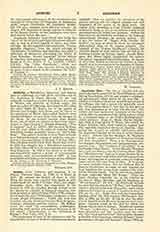

Aquileian Rite. —The See of Aquileia fell into schism during the quarrel of the Three Chapters (under Bishop Macedonius 539-56) and became a schismatical patriarchate, which lasted till the year 700. A number of allusions tell us that Aquileia and certain of its suffragan sees had a special rite (generally called the “ritus patriarchinus”); but they do not give us any clear indication as to what this rite was. The earliest and most instructive document of the Patriarchine Rite is a capitulare of the eighth century added by a Lombard hand to the “Codex Richdigeranus” (sixth century). Dom G. Morin (Revue benedictine, 1902, p. 2 sq.) and H. F. Haase, who edited the Codex (Breslau, 1865), show reason to suppose that this capitulare represents the use of Aquileia. Supposing this, it gives us valuable information about the Aquileian Calendar for the time it covers (Advent to June). Advent had five Sundays; St. Stephen’s Day is December 27, as in the Rites of Jerusalem–Antioch and their descendants. There is no Septuagesima; two Sundays (Sexuagesima and Quinquagesima) prepare for Lent. The “tradition of the symbol” is on the Sunday before Easter. It and Maundy Thursday have each two Masses, as in the Gallican Rites. There is a “Mid-Pentecost” feast, as in many Eastern Rites. We have then many indications of the divergence from Rome; this fragment of a calendar points to Gallican usages mixed with some from the East. If we accept the most probable theory that the Gallican Rite is Eastern (Antiochene) in origin, we may consider the local Aquileian Use as one more variant of the widespread Gallivan family. For the rest we are reduced to mere conjecture about this liturgy. There are many theories, especially as to its relation to the rites of Milan, Ravenna, and the fragments in “De sacramentis”, IV, 4-6. Dr. Buchwald defends the view that the prayers in “De Sacr.” are Aquileian. Aquileia adopted them from Alexandria, under whose influence she stood (so a synod of Aquileia declared in 381; op. cit., 47). Rome then took her Canon from Aquileia about the fifth century (Weidenauer, Studien, I, 1906, pp. 21-56). If this be true, the influence of Aquileia on the Western liturgy has been enormous. Aquileia would be the gate by which our Roman Canon came to Europe. Baumstark ascribes “De sacr.” to Ravenna. But he agrees that it came from Alexandria and that Aquileia used the same rite. The “ritus patriarchinus” then would be the same as the Rite of the Exarchate, which he defends (“Liturgia romana e liturgia dell’ esarcato”, Rome, 1904, pp. 168-73). We may accept as certain that Aquileia had from the time of the formation of separate rites (fourth century) its own use, that this use was not the same as that of Rome, that probably it was one more variant of the large group of Western Rites, connected by (Eastern?) origin, which we call Gallican, that it was probably really related to the old Milanese Rite and perhaps still more to that of Ravenna.
In the later Middle Age we hear of the “ritus patriarchinus” as yielding steadily to the Roman Rite. Ebner has published a very curious and important variant of our “Hans igitur” prayer, in litany form, attributed to Paulinus of Aquileia (about 850). For the importance of this see the author’s work, “The Mass” (London, 1912, pp. 149-150). De Rubeis in his “De sacris foroiuliensium ritibus” (Venice, 1754, pp. 228 sqq.) prints part of the Aquileian scrutiny of catechumens, of the ninth century. This is practically that of the contemporary Roman Ordines; so the Roman Rite was already replacing the other one (cf. Dom de Puniet,”L’ année liturgique à Aquilée” in “Revue bénéd.”, 1902, p. 1). Walafrid Strabo (ninth century) mentions “hymns” composed by Paulinus of Aquileia and used by him “in private Masses at the offering of the sacrifice” (de eccl. rerum ex. et increm. 25) . In 1250 Peter IV, Bishop of Castello in the Aquileian province, desired to adopt the Roman Rite. In 1308 and again in 1418 an attempt was made to restore the Aquileian Use at Venice. But in 1456 Callistus III granted permission to the Patriarch of Grado and Aquileia to follow Rome. After the Council of Trent and Pius V’s missal (1570) one after another of the cities which had kept the Aquileian Use conformed to Rome: Triest in 1586, Udine in 1596. Como alone made an effort to keep the old local use. In 1565 and 1579 diocesan synods still insisted on this. But in 1597 Clement VIII insisted on Roman Use here too. Only the Church of St. Mark at Venice kept certain local peculiarities of ritual, which apparently descended from the “ritus patriarchinus”, till the fall of the republic in 1807. But long before its final disappearance the Aquileian Rite in these local forms was already so romanized that little of its original character was left. Francis Bonomio, Bishop of Vercelli, who went to Como in 1579 to persuade its clergy to adopt the Roman Breviary, says that the local rite was almost the same as that of Rome “except in the order of some Sundays, and the feast of the Holy Trinity, which is transferred to another time”. So the “Missale pro s. aquileyensis ecclesiae ritu”, printed at Augsburg in 1494, breviaries and sacramentaries (rituals) printed for Aquileia, Venice, and Como in the fourteenth century, although still bearing the name of “ritus patriarchinus” (or “patriarchalis”), are hardly more than local varieties of the Roman Rite (for all this, see Le Brun, op. cit., and Baumstark, “Liturgia romana”, pp. 170-73).
ADRIAN FORTESCUE

